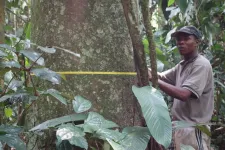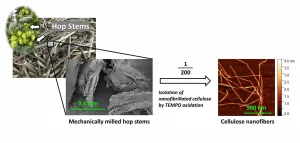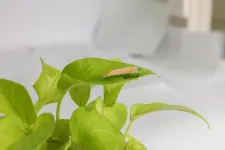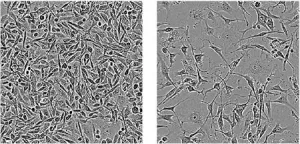Engineer's graphene additive manufacturing research makes journal's cover story
2021-07-02
(Press-News.org) MANHATTAN, KANSAS -- Research led by Kansas State University's Suprem Das, assistant professor of industrial and manufacturing systems engineering, in collaboration with Christopher Sorensen, university distinguished professor of physics, shows potential ways to manufacture graphene-based nano-inks for additive manufacturing of supercapacitors in the form of flexible and printable electronics.
As researchers around the world study the potential replacement of batteries by supercapacitors, an energy device that can charge and discharge very fast -- within few tens of seconds -- the team led by Das has an alternate prediction. The team's work could be adapted to integrate them to overcome the slow-charging processes of batteries. Furthermore, Das has been developing additive manufacturing of small supercapacitors -- called micro-supercapacitors -- so that one day they could be used for wafer-scale integration in silicon processing.
"Additive manufacturing is fascinating, cost-effective and has versatile design considerations," Das said.
The team has developed supercapacitors that have been tested for 10,000 cycles of charging and discharging cycles, a number that is promising to evaluate the reliability of these devices, Das said The team is also studying the versatility of these micro-supercapacitors by printing on mechanically flexible surfaces. For this, they used 20-micrometer-hin polyimide -- plastic -- substrates with high reliability. Das is highly interested in translating emerging materials to devices.
"When you think about best materials and wish to make the best devices, it is not simple and straightforward," Das said. "One needs to then understand the underpinning physics and chemistry involved in devices."
Another advantage of Das' invention is the green aspects of the research that he visualized through constructive discussions with Sorensen. When Das met Sorensen, he realized he could use his expertise in additive manufacturing to transform these materials into useful things; in this case, making tiny energy storage devices.
A few months later, Das filed for a U.S. patent after developing a nano-ink technology and used it to demonstrate printed micro-supercapacitors.
Das is particularly interested in forming this synergistic collaboration with Sorensen because of the energy-efficient, highly scalable and chemical-free nature of the graphene production process and his own group's graphene ink manufacturing process. Both of these processes are patented/patent-pending technologies and are industrially relevant, Das said.
"We make high-quality, multilayer graphene by detonating fuel-rich mixtures of unsaturated hydrocarbons such as acetylene with oxygen in a multi-liter chamber," Sorensen said. "Our patented method is simple requires very little energy, hence is ecologically benign; requires no toxic chemicals; and has been scaled up to yield high-quality, inexpensive graphene."
Graphene has been recognized as a wonder material with much potential because of its many superlative physical properties Many graphene manufacturing methods have been developed across the globe and graphene has been produced in ton quantities. Technologists, however, are well aware that graphene is not yet in the marketplace because none of these methods have had the right combination of economy, ecology and product quality to allow graphene to fulfill its potential. But both the methods of producing graphene and nano-inks pursued at Kansas State University are on target to address all of these requirements, according to Sorensen and Das.
INFORMATION:
The printed supercapacitor research, Graphene Aerosol Gel Ink for Printing Micro-Supercapacitors, was recently published as the cover article in the journal ACS Applied Energy Materials.
Former postdoctoral researcher Anand Gaur from the Das research team, several graduate students in Das and Sorensen's groups, and associate professor Brice LaCroix in the K-State geology department have contributed to this work. The work was supported by a grant from the National Science Foundation.
ELSE PRESS RELEASES FROM THIS DATE:
2021-07-02
A huge global network of researchers is working together to take the pulse of our global tropical forests.
ForestPlots.net, which is co-ordinated from the University of Leeds, brings together more than 2,500 scientists who have examined millions of trees to explore the effect of climate change on forests and biodiversity.
A new research paper published in Biological Conservation explains the origins of the network, and how the power of collaboration is transforming forest research in Africa, South America and Asia.
The paper includes 551 researchers and outlines 25 years of discovery in the carbon, biodiversity and dynamics of tropical forests.
Professor Oliver Phillips, of Leeds' School of Geography, said "Our new paper shows how we are linking students, botanists, ...
2021-07-02
MANHATTAN, KANSAS -- A recent study by Kansas State University virologists demonstrates successful postinfection treatment for SARS-CoV-2, the virus that causes COVID-19.
College of Veterinary Medicine researchers Yunjeong Kim and Kyeong-Ok "KC" Chang published the study in the prestigious journal Proceedings of the National Academy of Sciences of the United States of America, or PNAS. They found that animal models infected with SARS-CoV-2 and treated with a deuterated protease inhibitor had significantly increased survival and decreased lung viral load.
The results suggest that postinfection treatment with inhibitors of proteases that are essential for viral replication may be an effective treatment against SARS-CoV-2. ...
2021-07-02
How on Earth?
It has puzzled scientists for years whether and how bacteria, that live from dissolved organic matter in marine waters, can carry out N2 fixation. It was assumed that the high levels of oxygen combined with the low amount of dissolved organic matter in the marine water column would prevent the anaerobic and energy consuming N2 fixation.
Already in the 1980s it was suggested that aggregates, so-called "marine snow particles", could possibly be suitable sites for N2 fixation, but this was never proven.
Until now..
In a new study, researchers from the University of Copenhagen demonstrate, by use of mathematical models, ...
2021-07-02
During the large second wave of the COVID-19 pandemic in fall 2020, pulmonologist and critical care provider Juan C. Rojas, MD, reflected on how disproportionately members of minority populations were being affected by the disease. After hearing similar thoughts from colleagues in New Orleans and New York City, Rojas began to wonder how, if at all, state governments planned to ensure these disparities would be addressed when COVID-19 vaccines were rolled out to the public.
In a new study published July 2 in JAMA Network Open, Rojas and his team were surprised ...
2021-07-02
(Boston)--Would you be more willing to get vaccinated against the COVID-19 virus if you could participate in a lottery for cash and prizes? The answer was surprisingly no, according to Boston University School of Medicine (BUSM) researchers who found that Ohio's "Vax-a-Million" lottery-based incentive system, intended to increase COVID-19 vaccination rates, was not associated with an increase in COVD-19 vaccinations.
Prior reports in the media had suggested that the Ohio lottery increased COVID-19 vaccinations, leading other states to use COVID-19 vaccine incentive lotteries in an attempt to increase slowing vaccination rates. "However, prior evaluations of ...
2021-07-02
Some three quarters of the biomass in hop plants used in beer-making ends up in landfills. But a group of Japanese researchers has developed a technique that 'upcycles' that waste hop into cellulose nanofibers (CNFs). A paper describing the technique was published in the journal ACS Agricultural Science & Technology on June 11.
In the past few years, craft beer-making has exploded in popularity around the world, including many beer styles that make use of many more and different types of hops than conventional commercial beers. A traditional preservative in beer, hops also add ...
2021-07-02
Berkeley -- Many insects and spiders get their uncanny ability to scurry up walls and walk upside down on ceilings with the help of specialized sticky footpads that allow them to adhere to surfaces in places where no human would dare to go.
Engineers at the University of California, Berkeley, have used the principle behind some of these footpads, called electrostatic adhesion, to create an insect-scale robot that can swerve and pivot with the agility of a cheetah, giving it the ability to traverse complex terrain and quickly avoid unexpected obstacles.
The robot is constructed from a thin, layered material that bends and contracts when an electric voltage is applied. In a 2019 paper, the research team demonstrated that this simple ...
2021-07-02
Wander around a desert most anywhere in the world, and eventually you'll notice dark-stained rocks, especially where the sun shines most brightly and water trickles down or dew gathers. In some spots, if you're lucky, you might stumble upon ancient art - petroglyphs - carved into the stain. For years, however, researchers have understood more about the petroglyphs than the mysterious dark stain, called rock varnish, in which they were drawn.
In particular, science has yet to come to a conclusion about where rock varnish, which is unusually rich in manganese, comes from.
Now, scientists at the California Institute of Technology, the Department of Energy's SLAC National Accelerator ...
2021-07-02
Neuroscientists at the University of Massachusetts Amherst have demonstrated in new research that dopamine plays a key role in how songbirds learn complex new sounds.
Published in the Journal of Neuroscience, the finding that dopamine drives plasticity in the auditory pallium of zebra finches lays new groundwork for advancing the understanding of the functions of this neurotransmitter in an area of the brain that encodes complex stimuli.
"People associate dopamine with reward and pleasure," says lead author Matheus Macedo-Lima, who performed the research in the lab of senior author Luke Remage-Healey as a Ph.D. student in UMass Amherst's Neuroscience and Behavior graduate program. "It's a very well-known concept that dopamine is involved in learning. ...
2021-07-02
In cancer research, it's a common goal to find something about cancer cells -- some sort of molecule -- that drives their ability to survive, and determine if that molecule could be inhibited with a drug, halting tumor growth. Even better: The molecule isn't present in healthy cells, so they remain untouched by the new therapy.
Plenty of progress has been made in this approach, known as molecular targeted cancer therapy. Some current cancer therapeutics inhibit enzymes that become overactive, allowing cells to proliferate, spread and survive beyond ...
LAST 30 PRESS RELEASES:
[Press-News.org] Engineer's graphene additive manufacturing research makes journal's cover story





